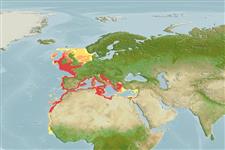Teleostei (teleosts) >
Eupercaria/misc (Various families in series Eupercaria) >
Cepolidae (Bandfishes) > Cepolinae
Etymology: Cepola: Latin, cepulla = onion.
More on author: Linnaeus.
Environment: milieu / climate zone / depth range / distribution range
Ecology
Marine; demersal; depth range 15 - 400 m. Subtropical; 61°N - 10°N, 18°W - 36°E
Eastern Atlantic: British Isles to north of Senegal, including the Mediterranean.
Length at first maturity / Size / Weight / Age
Maturity: Lm 24.2 range ? - ? cm
Max length : 80.0 cm TL male/unsexed; (Ref. 27156); common length : 40.0 cm TL male/unsexed; (Ref. 26999)
Dorsal
spines
(total): 0;
Dorsal
soft rays
(total): 67-70;
Anal
soft rays: 60. Body ribbon-like, gradually tapering to a pointed tail. Large, oblique mouth. Teeth widely spaced on both jaws. First two rays of dorsal fin unsegmented. Caudal fin with median rays longer and free at their tip. Dorsal and anal fins more or less joined to the caudal fin.
Found on sand and mud bottom (Ref. 26999). Lives in vertical burrows but may be found swimming in midwater. Occurs singly or in groups. Feeds mainly on small crustaceans and chaetognaths (Ref. 5984).
Eggs are pelagic.
Quéro, J.-C., 1990. Cepolidae. p. 853-854. In J.C. Quero, J.C. Hureau, C. Karrer, A. Post and L. Saldanha (eds.) Check-list of the fishes of the eastern tropical Atlantic (CLOFETA). JNICT, Lisbon; SEI, Paris; and UNESCO, Paris. Vol. 2. (Ref. 5985)
IUCN Red List Status (Ref. 130435)
Threat to humans
Harmless
Human uses
Fisheries: minor commercial
More information
ReferencesAquacultureAquaculture profileStrainsGeneticsElectrophoresesHeritabilityDiseasesProcessingNutrientsMass conversion
Tools
Can't connect to MySQL database fbquizv2. Errorcode: Too many connections
